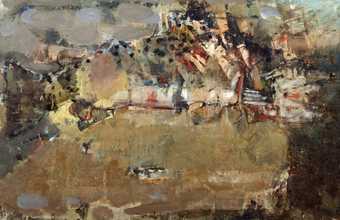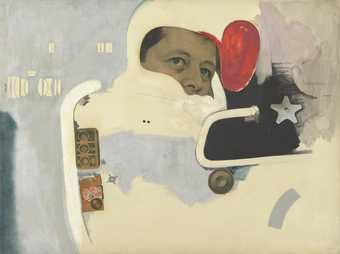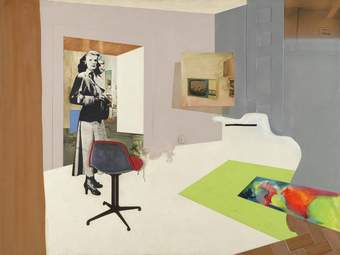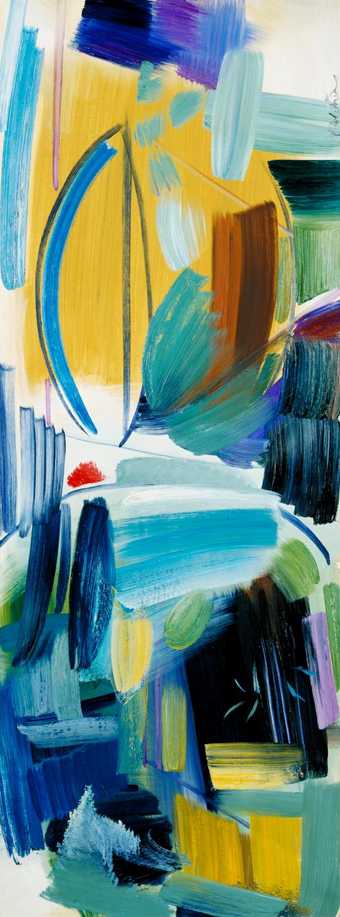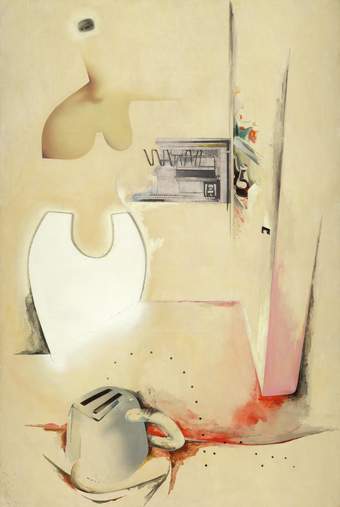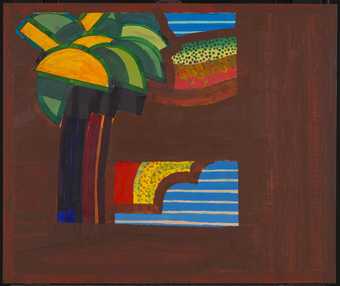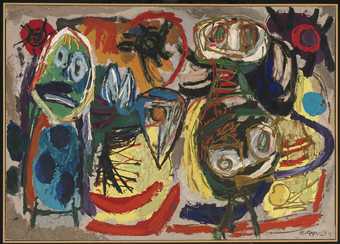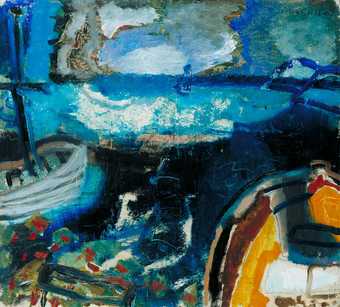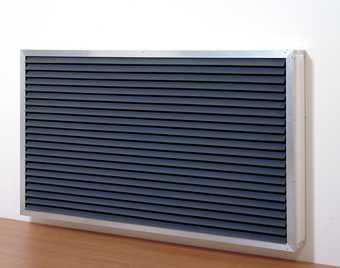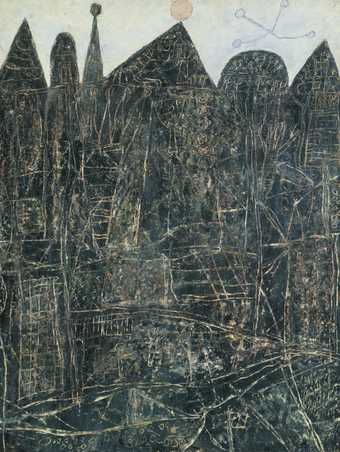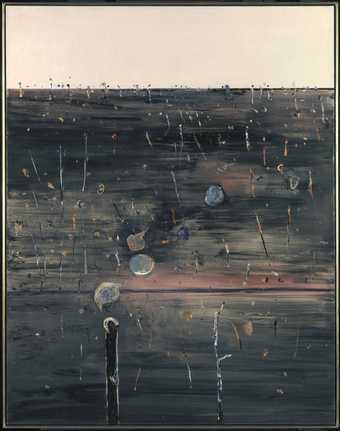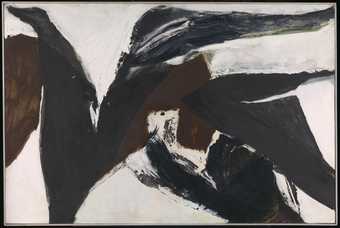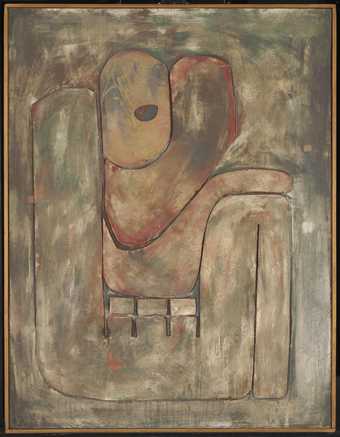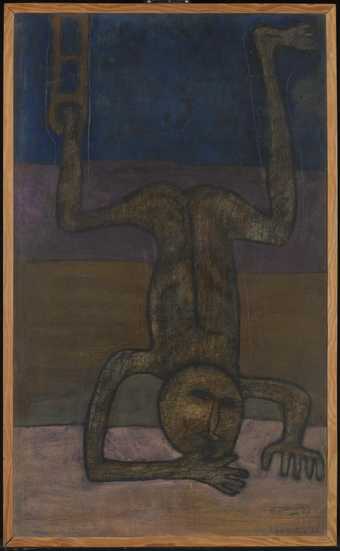
Not on display
- Artist
- Mohammed Melehi 1936–2020
- Medium
- Cellulose paint on wood
- Dimensions
- Frame: 1219 × 1032 × 43 mm
- Collection
- Tate
- Acquisition
- Purchased with funds provided by the Middle East North Africa Acquisitions Committee 2018
- Reference
- T15048
Summary
The title of the painting Casa is a common shortening for the city of Casablanca in the artist’s native Morocco. It can be read as an abstracted cityscape, informed by Melehi’s nomadic lifestyle which saw him travelling from Marrakech to Rome, Paris and New York. In the 1960s, during his stay in New York, he had already worked on a series of paintings with titles like New York, Above Manhattan and Sleeping Manhattan that set up a dialogue with the work of American painters such as Frank Stella, Ellsworth Kelly, Kenneth Nolan and Jules Olitski (whom Melehi met in the early 1960s when the American artist exhibited in Rome at Topazia Alliata Gallery, run by the mother of Melehi’s then wife, Toni Maraini).
Casa embodies a turning point in Melehi’s career – a shift from a canvas support to wood and the beginning of his use of cellulose paint rather than acrylic. This results in a lacquered surface quality that gives the painting a graphic feel. Broadly divided along a diagonal, running from top left to lower right, the composition features Melehi’s signature ‘wave’ motif, turned vertically to resemble flames. This practice of shifting the direction and rhythm of such motifs is typical of Melehi’s work. On other occasions, the wave motif could take on a political meaning, as in his graphic work for the journal Souffles, where his abstracted flames came to symbolise a celebration of the Palestinian cause. The wave also referred implicitly to the curves and swirls of Arabic calligraphy.
Casa is one of the first works that explicitly refers to a natural landscape – the wave and concentric circle motifs suggesting the sun and flames. The repetition of colourful stripes of red, yellow, orange, pink, green and blue creates a vibrating, almost hallucinatory effect. Melehi’s nod to American hard-edge abstraction, minimalist and even pop trends is apparent here, though he departs on a journey of his own, defining a style that expands into cosmic dimensions, as his first wife, the art historian Toni Maraini has explained:
Water, earth, fire, air, assembling and decomposing into sunrays, whirlpools, stars, rainbows, all part of a dramaturgy of natural elements, ouranian and cosmic forces. The interplay between the parts and the whole makes his painting simultaneously static and dynamic: the depth in its link to a vanishing point is often broken, split into two, giving birth to another surface; at times, inserted between a sunray and two interrupted colours, the lightning of an abyss appears in perspective.
(Maraini 2014, pp.130–1, translated by Morad Montazami.)
Melehi is an influential figure in Moroccan modernism. He was a key member of the Casablanca Art School (with Farid Belkahia and Mohammed Chabâa), an avant-garde group that radically questioned cosmopolitan abstraction and art pedagogy within the context of colonial powers and influences.
Further reading
Souffles, vols.7–8, Rabat, Morocco, 1969.
Moulim el-Aroussi, Identité et modernité dans la peinture marocaine, exhibition catalogue, Loft Art Gallery, Casablanca 2012.
Toni Maraini, ‘Paragraphes’ (1990), reprinted in Toni Maraini, Ecrits sur l’art, Casablanca 2014.
Morad Montazami
June 2017
Does this text contain inaccurate information or language that you feel we should improve or change? We would like to hear from you.
Explore
- abstraction(8,615)
-
- from recognisable sources(3,634)
-
- landscape(1,191)
- formal qualities(12,454)
-
- colour(836)
- environment / nature(315)
- cities, towns, villages (non-UK)(13,323)
-
- Casablanca(1)
- Morocco(41)
You might like
-
Paul Rebeyrolle Trout
1956 -
Richard Hamilton Interior II
1964 -
Ivon Hitchens Arno No. 5
1965 -
Richard Hamilton $he
1958–61 -
Howard Hodgkin In a Hotel Garden
1974 -
Karel Appel People, Birds and Sun
1954 -
Patrick Heron Boats at Night : 1947
1947 -
Julian Opie H
1987 -
Jean Dubuffet Large Black Landscape
1946 -
Fred Williams Burnt Landscape II (Bushfire Series)
1970 -
Trevor Bell Forces
1962 -
Hamed Abdalla Lost or Escaped
1966 -
Farid Belkahia Cuba Si
1961 -
Farid Belkahia Tortures
1961–1962

